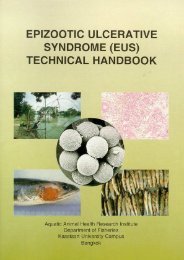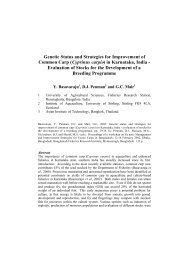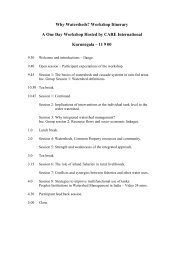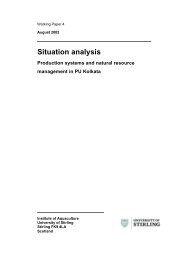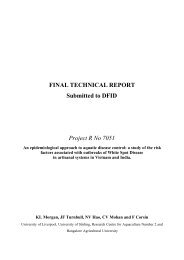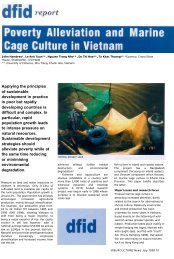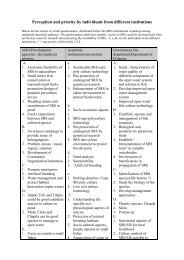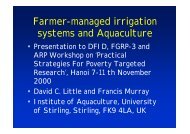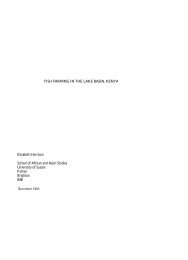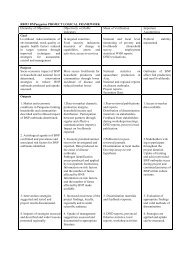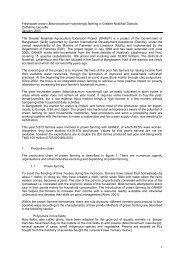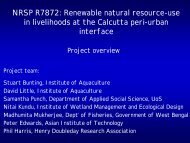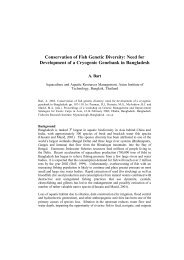Marketing of fish from peri-urban Kolkata - DFID@Stir - University of ...
Marketing of fish from peri-urban Kolkata - DFID@Stir - University of ...
Marketing of fish from peri-urban Kolkata - DFID@Stir - University of ...
- No tags were found...
You also want an ePaper? Increase the reach of your titles
YUMPU automatically turns print PDFs into web optimized ePapers that Google loves.
23. The quantities <strong>of</strong> <strong>fish</strong> sold per vendor and margin per kg tended to be higher for the largeimported IMC than for small live tilapias, IMC and exotic carps <strong>from</strong> <strong>Kolkata</strong> wetlands.Larger live carps and tilapia however attracted high prices and margins, but availability waslow. Gross incomes <strong>of</strong> people selling small carps and tilapias ranged <strong>from</strong> less than Rs200-500per day. <strong>Marketing</strong> costs usually around 15-20% <strong>of</strong> gross income.24. Scheduled caste or tribal people were most commonly involved in trading <strong>fish</strong>; depending onthe market, women were <strong>of</strong>ten active traders. Vendors specializing in selling large iced IMCtypically had a minimum <strong>of</strong> two people per stall, one <strong>of</strong> whom was involved in streakingand/or cleaning the <strong>fish</strong>. Vendors selling small live carps and tilapias and/or small wild <strong>fish</strong>tended to trade alone and have relatively smaller amounts <strong>of</strong> <strong>fish</strong> for sale. Cleaning <strong>of</strong> such<strong>fish</strong> is normally contracted by independents. Sitting among the traders, <strong>fish</strong> cleaners tend to bevery poor and earn Rs1-3 per time depending on the size and difficulty <strong>of</strong> the <strong>fish</strong> to becleaned.Consumers25. People generally prefer to purchase and consume a variety <strong>of</strong> species and sized <strong>fish</strong>,freshwater, marine, captured and cultured <strong>fish</strong> are all available in every market, although therange <strong>of</strong> produce available does vary between markets. Customers in <strong>Kolkata</strong> markets tendedto consume <strong>fish</strong> on a daily basis, whereas meat <strong>of</strong> all types is much less frequently consumed;<strong>fish</strong> were eaten on more than 5 occasions a week compared to less than once for all meat. Themean amount <strong>of</strong> <strong>fish</strong> bought was around 0.89 kg per customer. Better -<strong>of</strong>f consumers tended toconsume <strong>fish</strong> more frequently than poorer people, although even the poorest group consumed<strong>fish</strong> more than 4 times per week on average.26. Approximately 50% <strong>of</strong> people interviewed had a negative opinion on the use <strong>of</strong> wastewater toraise <strong>fish</strong>, the remainder having a positive perspective or no opinion. Consumers purchasedbetween 400g to over 2 kg <strong>of</strong> <strong>fish</strong> on each occasion. Based on the amounts bought on eachoccasion and the stated frequency <strong>of</strong> consumption and household size, per capita consumption<strong>of</strong> aquatic products exceeds 60 kg annually.27. The timing <strong>of</strong> the survey may have influenced the relative abundance and importance <strong>of</strong>wastewater reared <strong>fish</strong> compared to other sources as supplies were relatively low at this time.The substitution <strong>of</strong> other sources for wastewater <strong>fish</strong> seems clear and only a longitudinalsurvey would determine if imported IMC varied significantly through the year. Recall <strong>of</strong> thevendors suggests that markets for large IMC continue to expand and not prone to largevariation in this respect.5
Size <strong>of</strong> <strong>fish</strong> (g)200150100500Auction marketsSize <strong>of</strong> <strong>fish</strong> soldJ F M A M J J A S O N DMonthFour <strong>of</strong> the major markets in the East <strong>Kolkata</strong>Wetlands were monitored throughout 2002,Bamanghata (Baman), Bantala (Ban),Chowbhaga (Chow) and Chingrighata (Ching).The main trends indicated a gradual increase inthe number <strong>of</strong> traders involved at each marketover the last decades by a factor <strong>of</strong> up to 6.Bamanghata is the largest market in terms <strong>of</strong>both the numbers <strong>of</strong> traders and the averagesize <strong>of</strong> trade. Bamanghata is located morecentrally within the wetlands and <strong>fish</strong> <strong>from</strong> thismarket also is sold on through Chowbhaga andBantala auction markets as well as directly to arange <strong>of</strong> retail markets (See Appendices)Fish sold (kg/saler)numbers <strong>of</strong>traders212019181716806040200Increasing numbers <strong>of</strong> wholesalers1950 1960 1970 1980 1990 2000timeTotal <strong>fish</strong> soldBan Baman Ching ChowFish AratBanBamChingChowCurrently more than 200 auctioneers tradedaily through the year although volumes <strong>of</strong><strong>fish</strong> traded can vary by almost 100%. Thenumber <strong>of</strong> trades made each day remainssimilar but the average amounts traded/salevaries. More <strong>fish</strong> is traded in the months May-October and least between November andApril. At least 4 people are employed for eachauction trading house (auctioneer, writer,sweeper and accountant) and many casuallabourers find employment carrying water.correlates with the main production cycle.Stocking occurs year-round <strong>from</strong> nurseryponds, usually operated by the same bherioperator and <strong>fish</strong> are then ‘thinned’ out andsold throughout the year. The smaller size <strong>of</strong><strong>fish</strong> later in the year could be explained bymid-season stocking <strong>of</strong> nursed fingerlings.Hatchlings are available for much <strong>of</strong> the yearbut are cheapest in the mid-season (April-September).Price <strong>of</strong> <strong>fish</strong> (Rs/kg)403020100Price <strong>of</strong> <strong>fish</strong> soldJ F M A M J J A S O N DMonthOverall it is estimated that in excess <strong>of</strong> 18,000MT <strong>of</strong> <strong>fish</strong> are being traded through these 4markets annually, mainly <strong>from</strong> the bheries.Fish yields in excess <strong>of</strong> 4,500 MT/ha (based ona figure <strong>of</strong> 4,000 ha) appear to be sustained.SpeciesExotic species, especially tilapias have becomeincreasingly important over the last fewdecades Two main types <strong>of</strong> tilapia areidentified by producers, intermediaries andconsumers; the darker ‘tilapia’ (Oreochromismossambicus) and the lighter ‘lylantica’(Oreochromis niloticus). The latter nowpredominates although the former isconsidered su<strong>peri</strong>or by consumers and togetherthey constitute 40 - 50% <strong>of</strong> the wetlandsproduction. Most arotdars were <strong>of</strong> the opinionthat the level <strong>of</strong> tilapia produced and tradedhas been increasing partly because it is cheaperto produce and is high demand, especially<strong>from</strong> poor consumers. . Key informants in allfour markets confirmed that tilapias began toappear in the early 1960’s, Nile tilapia in themid-1980s and common carp and silver carp inthe mid-1970s. Clearly some <strong>fish</strong> traded atthese auction markets is derived <strong>from</strong>aquaculture and rice-fis h <strong>fish</strong>eries outside <strong>of</strong>the wetland area proper. Small wild specieswere quite common in the markets duringDecember and this was related to the riceproduction cycle and a tendency to drainbheries and catch residual <strong>fish</strong> at this time <strong>of</strong>year.Both the mean size <strong>of</strong> trade and the averagesize <strong>of</strong> <strong>fish</strong> sold increases during the seasondemonstrating a seasonality <strong>of</strong> supply that7
ReferencesSaha, K.C. 1970. Fisheries <strong>of</strong> West Bengal. 121ppMorrice, C., Choudhury, N.I. and Little, D.C. 1998. Fish markets in Calcutta. Aquaculture Asia 3(2),12-14.11
Appendices(1) Bamanghata auction market and linkages with retail markets12
(2) Bantala auction market and linkages with retail markets13
(3) Choubagha auction market and linkages with retail markets14
(4) Chingrighata auction market and linkages with retail markets15
(5) Bamanghata auction market and linkages with bheries16
(7) Choubhaga auction market and linkages with bheries18
CHINGRIGHATAGOLTALAMADHUMITAKULBERIAINFLOWCHANDIPURNOTE :: THE DIFFERENT COLOURS USED ARE ONLYFOR PRESENTATION PURPSE AND DOESN’T IMPLYANY SPECIAL MEANING(8) Chingrighata auction market and linkages with bheries19




